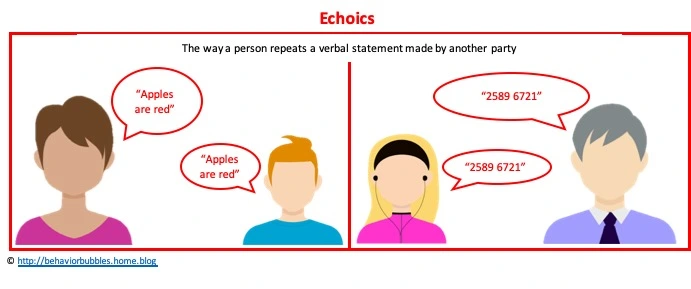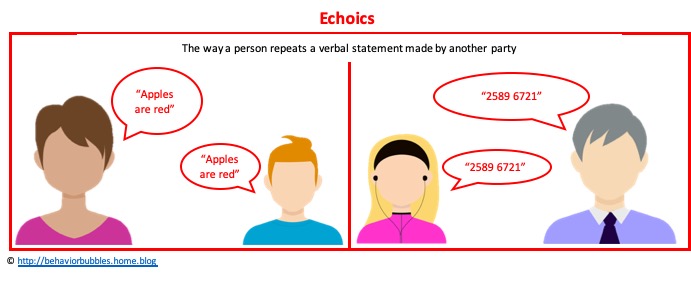According to Cooper, Heron & Heward (2007), an echoic is a verbal operant that occurs when a speaker repeats the verbal behaviour of another speaker”.
In order to define it as an “echoic”, it is important for the response to: (1) match the sound/statement exactly; and (2) resemble the format (i.e. verbal with verbal). For example, should the instructor say “hello”, the learner will echo the word stated (i.e. “hello”) instead of a different word (i.e. “hi”).
Echoics is similar to imitation where the learner’s response should match the given stimulus exactly. However, while imitation looks at copying a physical movement, echoics looks at copying a verbal stimulus.

Types of Echoics
Different types of echoics that can be taught include the following:
– Simple sounds (/a/);
– Multiple combination of sounds (/ma-pa/);
– Speed (i.e. fast vs. slow);
– Pitch (high vs. low);
– Number of words; and
– Number of numbers;
– etc.
Teaching a combination of the different types of echoics helps a learner to work on their focus and improve their differentiation of sounds heard (i.e. /ah-ma/ versus /ah-ee/), the pronunciation of words/sounds (i.e. through shaping), and the length of utterances (i.e. single words to sentences).
Importance of Teaching Echoics
It is important to teach echoics as the skill of echoing can transferred to the other verbal operants such as manding (requesting), tacting (labelling), and intraverbals(conversations). This would be done by generalising the response through prompts and prompt fading techniques.
Echoics can be utilised independently and can be seen in our day-to-day activities. For example, imagine what you would do when you answer a call and need to record down the given contact number to call back later. Upon the caller providing the contact number “4893 1823”, the respondent would echoic back the number heard (i.e. “4893 1823”) to confirm that they got the correct details. Moreover, whilst on the phone, we tend to echoic back important information heard to ensure that the information was delivered accurately.
________________________________________________________
In future posts, we will look into the other domains that can be taught to a learner.
Happy Teaching!
References
Cooper, J. O., Heron, T. E., & Heward, W. L. (2007). Applied behavior analysis (2nd ed.). Upper Saddle River, NJ: Pearson.


